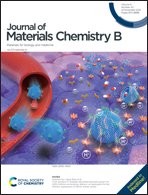Development of copper vacancy defects in a silver-doped CuS nanoplatform for high-efficiency photothermal–chemodynamic synergistic antitumor therapy
Abstract
The combination of chemodynamic and photothermal materials can not only improve the therapeutic effect of chemodynamic therapy (CDT) by thermal stimulation, but also play a synergistic therapeutic role. Benefitting from the strong near-infrared absorption ability, copper sulfide (CuS) nanomaterials are widely used in photothermal therapy. However, due to the harsh preparation conditions, low photothermal efficiency and poor biocompatibility, further biomedical application is limited. In this work, silver-doped copper sulfide nanoparticles (BSA-Ag:CuS) were synthesized using a biomineralization strategy using bovine serum albumin (BSA) as a template and stabilizer. Silver doping greatly improved the near-infrared absorption and photothermal efficiency of CuS nanoparticles, which can be used for 1064 nm laser-guided photothermal therapy (PTT). Meanwhile, BSA-Ag:CuS nanoparticles had a synergistic therapeutic effect with CDT and thus showed excellent antitumor performance. In vivo and in vitro biological experiments have shown that BSA-Ag:CuS nanoparticles have good stability, low toxicity, good biocompatibility and strong antitumor ability, and are promising as antitumor agents for future clinical cancer treatment.



 Please wait while we load your content...
Please wait while we load your content...